Assessing scenarios for oil amid unrest in the Middle East
.png)
Hamas' assault on Israel came as a geopolitical shock. As the situation escalates, potentially drawing in other players in the Middle East, there are implications for crude-oil prices.
This blog examines the oil market’s geopolitical linkages and the potential for supply disruptions.
Early market reaction was stronger than Russia-Ukraine in 2022
The Monday after the attacks saw an immediate reaction in the market for commodities and safe-haven assets.
Crude-oil prices jumped by about 5 percent. Gold rose 1.5 percent. And US government bonds rose, with 10-year yields falling about 12 basis points. These sharp market movements give a glimpse of the uncertainty being priced into this conflict. As our first chart shows, these moves were stark when compared to the first two trading days after Russia invaded Ukraine last year. (To be sure, market reactions in other assets were relatively contained; the S&P 500 initially sold off, but quickly reversed).
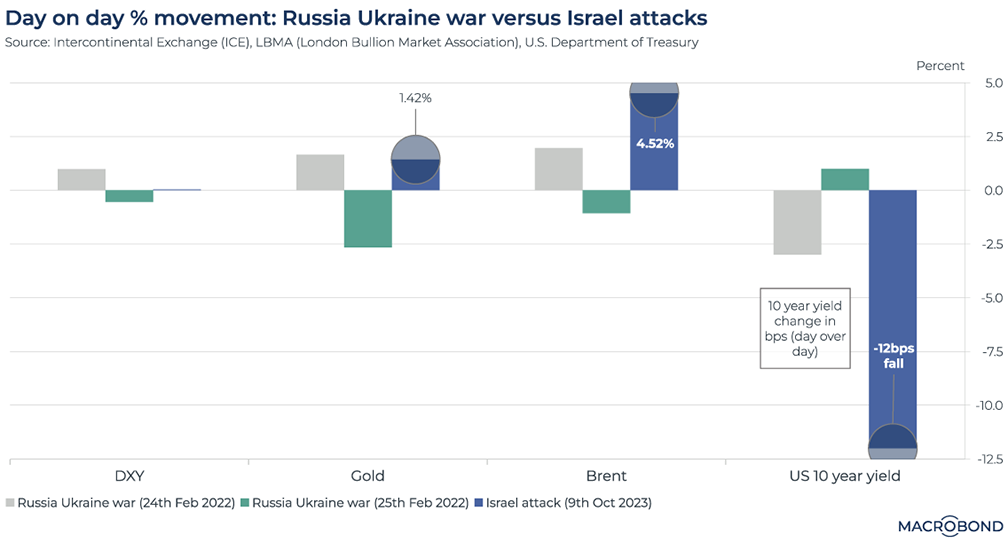
Turning to the options market, there was a steep decline in the ratio of put volume versus call volume for the West Texas Intermediate (WTI) oil price, as the second panel of the next chart shows. This is indicative of upward price risks.
A put/call ratio below 1 implies there are more expectations of a price rally versus a drop. On Monday, the put/call ratio dipped sharply to about 0.4 from closer to 1.25 earlier.
The chart’s top panel charts the WTI price in 2023 and shows periods shaded in gray where the put/call ratio was below 1; broadly, these coincide with rising crude prices.
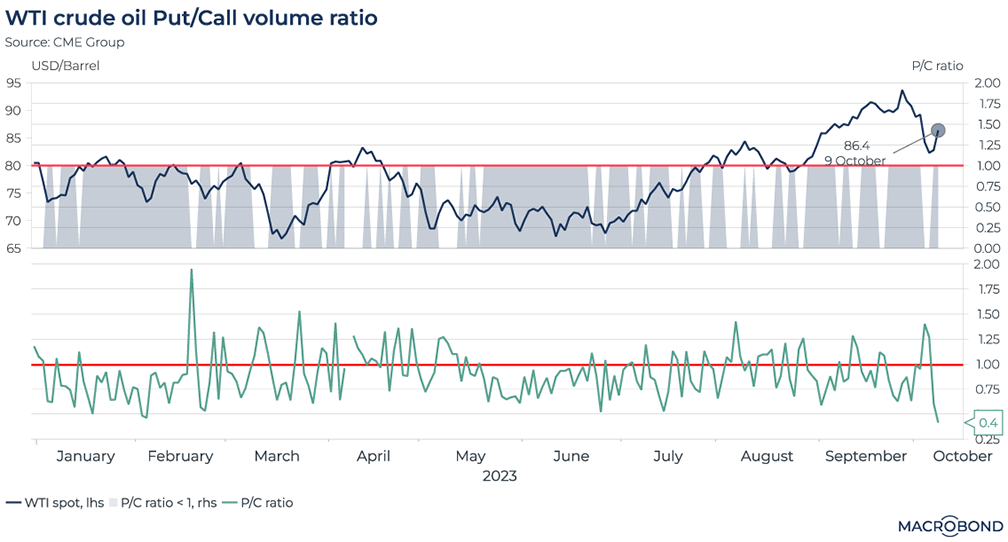
The importance of the Gulf producers
Israel and the Palestinian territories are not key oil producers, but many nations in the wider region are. The Middle East as a whole accounts for almost a third of global oil supply; Saudi Arabia accounts for about 12 percent and Iran about 4 percent. Iraq, the United Arab Emirates, Kuwait and Qatar are also significant producers.
The next chart tracks oil production by countries bordering the Persian Gulf over the years.
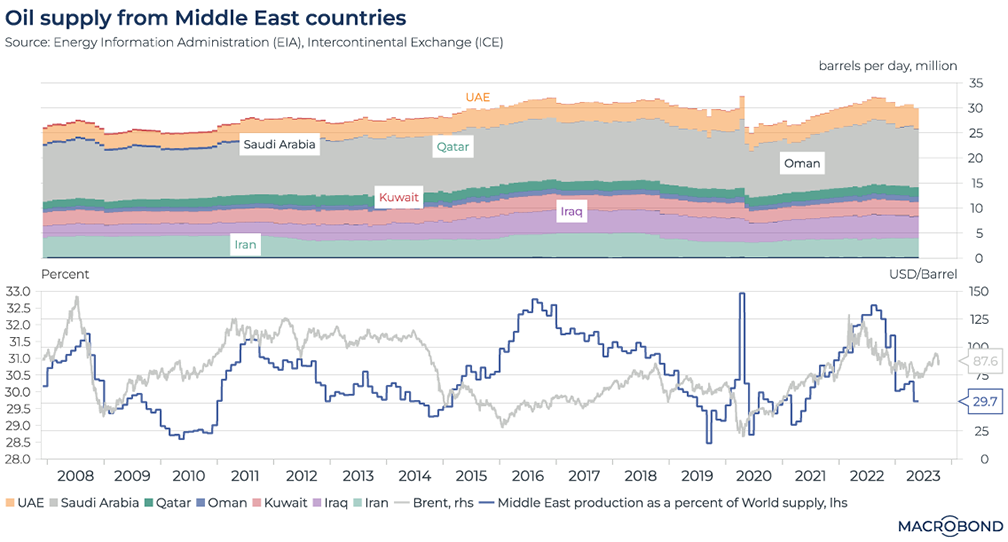
The bottom pane of the chart tracks the Brent crude price’s relationship to Middle East oil production as a percent of world supply. This is where we see the price impact of OPEC’s production cuts and increases: the move to pump more oil from late 2014 is clearly visible, as is the sustained period of low prices that followed. OPEC’s production cut in late 2022 can also be seen.
Downside risks to supply from Saudi Arabia and Iran
The Israel-Hamas war comes at a delicate time.
Prior to the attacks, Saudi Arabia signaled to Washington that it could boost production in 2024, if required, to keep oil price pressures in check – but also as part of a deal that could see a normalisation of Saudi diplomatic relations with Israel and greater defense cooperation with the US (according to the Wall Street Journal).
As the war reduces the probability of a Saudi rapprochement with Israel in the short term, it lessens the chances of such a 2024 supply increase.
There are also downside risks to Iranian production. Before Hamas’ attack, in mid-September, the US and Iran agreed to release prisoners in a move that was seen as de-escalating tensions and potentially allowing for a gradual rise in Iranian oil sales.
However, given Iran’s ties to Hamas, the conflict instead raises the possibility of tighter US sanctions on Iran.
The next chart is a different visualisation of the importance of Saudi and Iranian crude, which together account for about 16 percent of global supply. A month-on-month decline in combined Saudi and Iranian oil production in the past quickly translated into steeper month-on-month price changes and sharp volatility. The pandemic disruptions are most notable, but there are other month-on-month spikes of up to 25 percent.
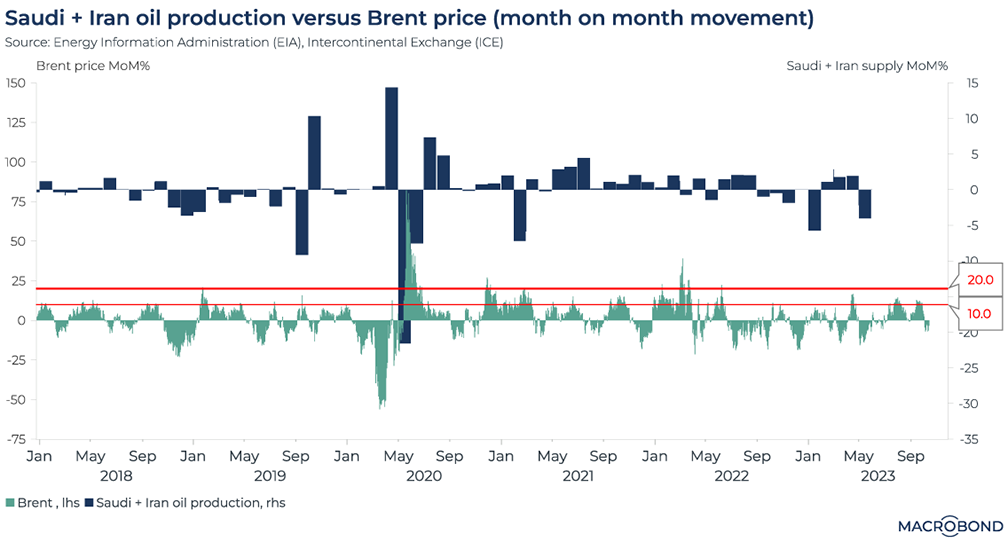
Modeling price scenarios: USD 100-plus oil in 2024?
Crude prices are a function of several supply and demand dynamics.
Demand is driven by 1. overall economic growth; 2. growth potential in emerging markets, which are large oil consumers; 3. demographic and employment trends; 4. macroeconomic indicators, such as growth, inflation and exchange rates. (We’re currently looking at a world of slowing GDP growth, concern about oil demand in China and sticky inflation that is denting consumers’ purchasing power.)
Supply factors include: 1. different sources of oil becoming viable to produce at various price points; 2. technological advancements influencing substitute production; 3. weather patterns; 4. regulatory changes, especially environmental policy; and 5. geopolitical events.
Using Macrobond’s partnership with Indicio, we constructed forecasting models to help gauge broad Brent price trends for:
- Status quo – no supply impact from the war; and
- A scenario where oil supply is reduced
Our models‘ input parameters included broad macro indicators, such as world GDP growth; demand, i.e. oil consumption as released by OPEC; and oil production trends. Oil supply and year-on-year GDP growth estimates have the greatest influence on price trends.
All other things being equal, given a backdrop of slowing economic growth, Indicio’s weighted output from univariate and multivariate models predicts that Brent crude will slip toward USD 86 per barrel over the next year.
We then ran the scenario analysis for adverse geopolitical fallout from a continued war in Gaza.
If we factor in a 0.3 mbpd reduction in oil output from Saudi Arabia, we end up with a significantly higher oil price in a year’s time – closer to USD 103/barrel.
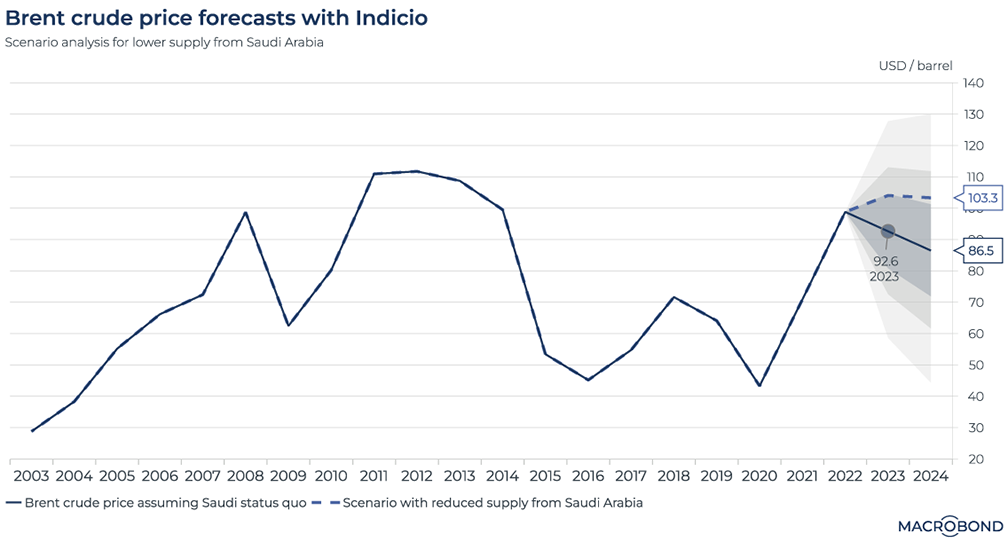
Learn how you can forecast like a PhD quant with Macrobond x Indicio.
3 topics
.png)
Macrobond delivers the world’s most extensive macroeconomic & financial data alongside the tools and technologies to quickly analyse, visualise and share insights – from a single integrated platform. Our application is a single source of truth for...
Expertise
.png)
Macrobond delivers the world’s most extensive macroeconomic & financial data alongside the tools and technologies to quickly analyse, visualise and share insights – from a single integrated platform. Our application is a single source of truth for...
.png)